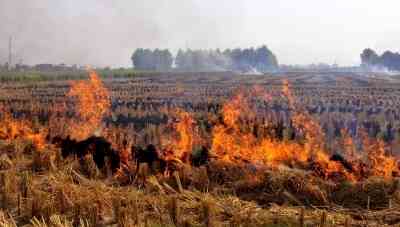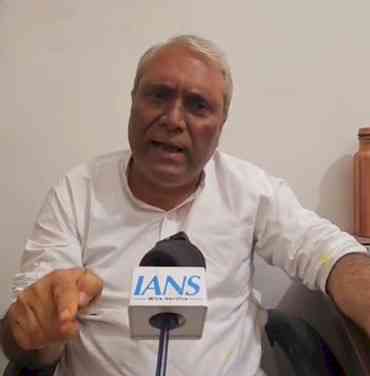Punjab sees surge in stubble-burning cases; Haryana witnesses decline
Smoke from the burning of agricultural crop residue by farmers in Punjab and Haryana contributes to Delhi's poor air, increasing the risk of acute respiratory infection for those living in districts with intense crop burning.

Vishal Gulati
Chandigarh, Nov 4 (IANS) Smoke from the burning of agricultural crop residue by farmers in Punjab and Haryana contributes to Delhi's poor air, increasing the risk of acute respiratory infection for those living in districts with intense crop burning.
The reason for smog with the onset of winter annually is farmers try to maximise their yields by planting the next crop generally wheat after rice as soon as possible after the previous crop has been harvested.
However, the AAP-ruled Punjab has seen a sudden spike in stubble-burning incidents since October 29, while the BJP-governed Haryana has been witnessing downward trend largely due to strict enforcement, real-time reporting and the deployment of district and block-level enforcement teams.
Agricultural experts say to quickly clear the field for the next crop, the farmers burn the leftover paddy straw rather than using the traditional method of clearing it by hand or adapting option of sustainable millet cultivation to break the paddy-wheat crop rotation introduced during the Green Revolution era (1967-1978).
Besides smoke from burning crop stubble, vehicle exhaust and factory emissions combine every winter to blanket Delhi in a choking haze largely owing to reduced wind speed after the withdrawal of the monsoon and cold winds from the Himalayas.
Levels of the most dangerous PM2.5 particles -- so tiny they can enter the bloodstream -- were on Saturday 132 times more the daily maximum recommended by the World Health Organization in several localities of the national capital.
NASA images show how stubble-burning continues unabated in Punjab. Smog from these farm fires blanketing Delhi.
The Haryana government claims NASA images show over double stubble burning in Punjab compared to it.
Wheat stubble is used as fodder for animals, while rice residue is not used and its burning is the easiest way to dispose of it.
A small proportion of farmers have been opting super seeder for planting wheat in rice plant residue.
Punjab experienced a significant spike, with 5,140 farm fire incidents in the first three days of November.
This surge came after a month of relatively low smoke levels in October, when only 7,673 stubble-burning incidents were reported in 47 days from September 15.
The next fortnight is likely to aggravate the situation as paddy is yet to be harvested on 10 lakh hectares in Punjab.
The total paddy sown this time was 31.93 lakh hectares, the record cultivation.
Amritsar district reported the highest number of farm fire cases in a single day at 993, followed by Sangrur (987), Tarn Taran (928) and Ferozepur (784). Amritsar, Tarn Taran and Ferozepur ring around Pakistan.
According to the Punjab Pollution Control Board, Bathinda was the most polluted city on November 3 with an AQI (air quality index) 353, higher than the AQI of 238 the same day in 2022.
In Ludhiana, the AQI stood at 238, compared to 319 last year.
In Haryana, 1,296 cases of stubble burning have been reported till November 3.
The maximum cases have been reported from Fatehabad, Kaithal, Jind, Ambala and Kurukshetra.
Interestingly, Gurugram, Mahendergarh, Nuh, Rewari and Charkhi Dadri, located in the vicinity of the National Capital Region (NCR), have not recorded any stubble burning cases till now.
Contrary to government’s claims, AAP leader Ashok Tanwar posted a video on X of huge stubble burning near the national highway in Haryana and blamed the state government for not providing any assistance to farmers to scientifically dispose of the residue.
Despite abysmal farm fires, the Central Pollution Control Board (CPCB) bulletin says the AQI value of Haryana’s towns Bahadurgarh (404), Faridabad (460), Fatehabad (432), Hisar (456), Jind (447), Rohtak (424) and Sonepat (455) was ‘severe’ on November 3.
Haryana Chief Secretary Sanjeev Kaushal told IANS the government has implemented stringent measures to further reduce paddy straw burning.
He said there is about 38 per cent reduction in stubble burning incidents this year compared to the previous year. In 2022, the state recorded 2,083 cases of stubble burning, which decreased to 1,296 cases in 2023, a decline of 38 per cent incidents.
There were 3,038 cases in 2021.
When compared to 2021, the straw burning incidents saw a substantial 57 per cent reduction in 2023.
Karnal and Kaithal districts saw over a 60 per cent reduction in farm fires compared to 2022.
The Chief Secretary attributed the decline in fire farms to stringent actions.
The government imposed 939 challans with fines totaling over Rs 25.12 lakh by October 31.
Also officers responsible for farm fires have been called to explain their actions and also suspended the erring officials.
Haryana’s comprehensive strategy includes both in-situ and ex-situ management, with a focus on categorising villages into Red, Yellow, and Green zones based on active fire incidents.
The government is providing crop residue management (CRM) machines to farmers on a subsidy, with 19,141 machines already sanctioned against the provision of 7,572 to the farming community.
(Vishal Gulati can be contacted at [email protected])


 IANS
IANS 








